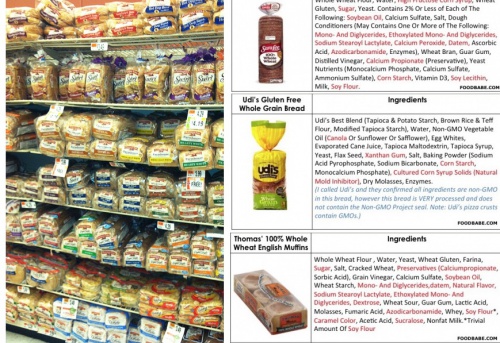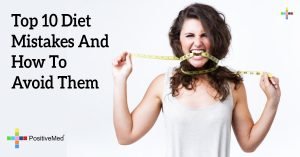Here’s How To Find The Healthiest Bread At A Grocery Store
Maintaining tip top health and physical fitness is undoubtedly a beneficial lifestyle choice. There are many ways of going about this process, and these include regular workouts, regular medical checkups, and a well-balanced diet. Regulating the diet have in particular is an especially powerful way to affect health in a positive manner. Because of this, individuals will want to consume foods that include the healthiest possible ingredients.

Unfortunately, many widely consumed foods fall far from this ideal. Indeed, many people would be very surprised to learn about some of the ingredients in garden-variety white bread. This article will take a closer look at the thus subject, and answer some questions that are relevant to the subject. These questions include: what goes into a loaf of average bread? What should be looked for in a good loaf?
WHAT GOES INTO THE AVERAGE LOW QUALITY LOAF OF BREAD?
Mass-produced and largely unhealthy processed bread do a good job of mimicking the look – and feel – of bread that are produced with all-natural ingredients. That said, these looks are really just a thin facade for some of the strange – and hazardous – ingredients that lurk within. Let’s examine a few of these rogue additives.
BLEACHED FLOUR
Many modern commercial low-quality bread are made from flours that come from an only part of the grain. These flours use only the starchy inner portion -the endosperm – and at the same time discards the other layers. These outer portions, that include the germ and the kernel, contain a large percentage of the nutrients. These vitamins, minerals, and fiber are thus lost forever.
Not only that but in many cases this flour is then bleached, to unnaturally whiten and soften it. Is important to note that unbleached flour will, on its own, soften and lighten up if it is given 8-12 weeks to do so. Many commercial operators can make more money by artificially accelerating this process, with the use of bleaching agents. This can age the flour in as little as 48 hours, but brings some serious health risks long with it. This is because many of the chemicals used in the process are quite toxic. They include things like chlorine, chlorine dioxide gas, azodicarbonamide, and benzoyl peroxide.
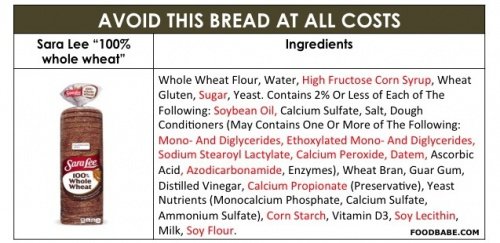
Apart from the many health problems that each one of these chemicals causes on its own, the overall bleaching process creates a byproduct that is known to cause diabetes in laboratory animals. As can be seen, there’s a lot wrong with bleached and processed white flour.
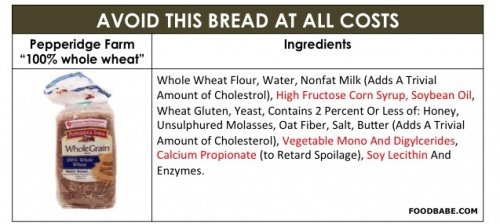
RELATED ARTICLE: Here is What Happens to Your Body When You Cut Out Bread from your Diet!
DATEM/MONO AND DIGLYCERIDES
Because many of these bread are produced at factories that are far from their eventual points of consumption, and because they will likely sit on shelves for possibly weeks at a time, many manufacturers pump these bread full of hazardous preservatives. These include mono and diglycerides as well as DATEM, a kind of dough conditioner. Dough conditioners help strengthen the dough during the production process, and the ‘glycerides’ allow manufacturers to bypass using natural naturally occurring lipids – and save money doing so. This may keep the bread from going stale as rapidly, but these dangerous trans-fats can wreak havoc on the human body.
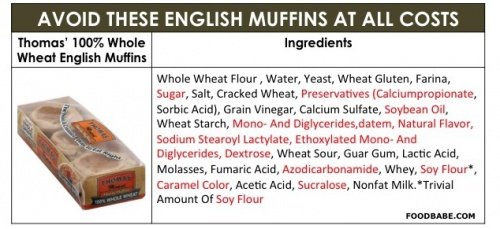
GENETICALLY MODIFIED ORGANISMS
Genetically Modified Organisms, or GMO’s, have been repeatedly foisted on the public by certain multinational chemical companies. These foods were initially marketed as highly nutritious improvements over what is provided by Mother Nature. Subsequent studies have established that they are actually less nutritious, and are actually bred for the purpose of being resistant to highly toxic pesticides. Because of this, shoppers should take special care to make sure that their bread contains no traces of these untested – and unsafe – substances.
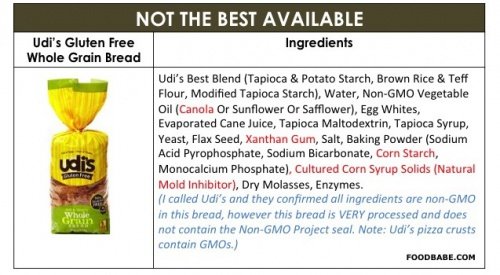
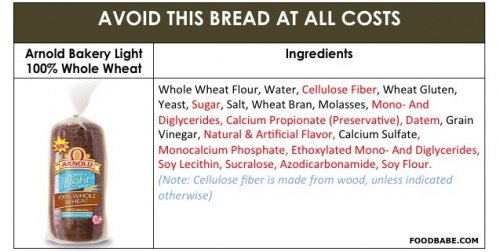
ARTIFICIAL SWEETENERS
On top of everything else, many mass produced and low-quality bread are manufactured with high fructose corn syrup, bleached white sugar, and others.These sweetening agents have been extensively studied, have little nutritional value, and can actually contribute to certain forms of cancer. Quite obviously, these should be avoided like the plague.
WHAT INGREDIENTS SHOULD GO INTO A GOOD HEALTHY LOAF OF BREAD?
Now that many of the negative and undesirable ingredients that are common in many modern pieces of bread have been discussed, it’s time to take a look at the bright side. There are many reputable and conscientious bakeries that put love – and healthy ingredients – into every loaf. What are some of the most desirable ingredients?
ANCIENT GRAINS
These grains are so called because they have been unchanged for many millennia. They pack a powerful nutritional punch, and when turned into flour, can be used to make delicious loaves of gluten free bread. Some common ancient grains include brown rice, amaranth, quinoa, millet, and sorghum.
SPROUTED GRAINS
Sprouted grains are grains that have hadn’t completed the growth process yet. In order to sprout grains, they are soaked in water until a small shoot emerges. Once they are sprouted and dried, they are then ground into flours. Sprouted grain flours contain complex carbs that will provide long-lasting energy throughout the day. They also contain necessary minerals, vitamins, antioxidants.
As can be seen, there’s a lot to be considered when making choices about which foods to purchase. That said, individuals that apply the information found in this article will enjoy better health than ever.
